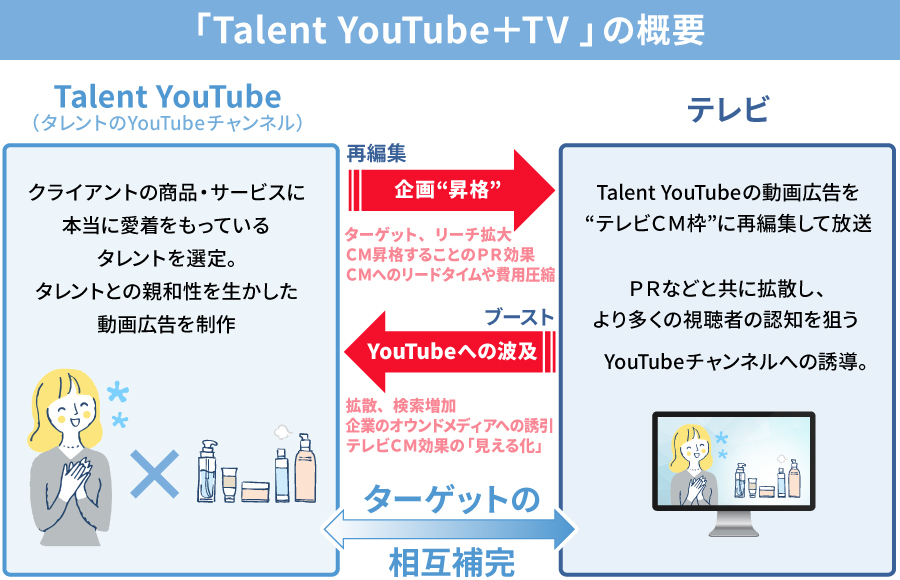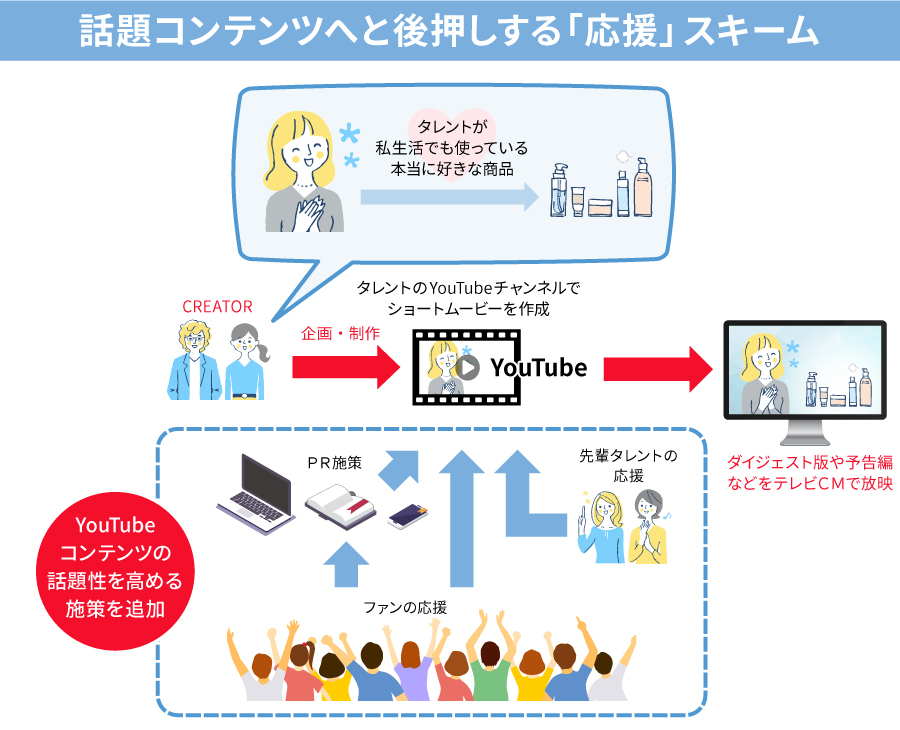As time spent at home increases due to the pandemic, YouTube continues to grow in prominence and is watched by a wide range of age groups. Last time, we covered the market overview, appeal, and current state of corporate marketing activities utilizing YouTube.
This time, Kosaku Tsukada, Head of Sales at FIREBUG (*), which handles talent and corporate content production in the digital space, and Hiroshi Kawasaki of Dentsu Inc., who develops new business with broadcasters, discuss the relationship between YouTube and TV, and the solution "Talent YouTube+TV" that maximizes the effectiveness of video advertising.
※FIREBUG: Primarily active in the digital sphere, FIREBUG offers a wide range of services including talent SNS consulting, content production and support, and artist production. Centered on entertainment, it also provides multifaceted marketing solutions to companies. It formed a business partnership with Dentsu Inc. in November 2020.
YouTube and TV are complementary
Tsukada: What I strongly feel now, working in digital advertising sales, is that advertising methods and types are becoming increasingly specialized. Previously, the approach often involved mass-airing TV commercials to build awareness for products or services, but now there are more advertising options tailored to specific targets.
Kawasaki: I currently support broadcasters and content holders in advancing their DX (digital transformation). Advertisers are naturally aware of the differences between TV and digital. These include the distinct characteristics of TV commercials versus digital ads, differences in audience demographics, and the greater ease of measuring advertising effectiveness with digital.
In recent years, celebrities have actively expanded into the digital space themselves, launching YouTube channels, personal websites, and social media accounts to broaden their platforms. This has also created a trend for advertising to shift toward digital. That said, it's not simply a case of digital being better than television. I believe that for both, "who speaks about the product or service" is particularly crucial.
Tsukada: Within that, YouTube and TV have different audiences, so they can complement each other in reaching target demographics. Depending on the concept, these two can be highly synergistic.
Kawasaki: Television is mass media, so it inevitably tends to require content that follows a framework aimed at the general public, making it very difficult to broadcast something truly surprising to the world.
In contrast, YouTube is a highly personal platform. One of its strengths is the ability to share content that's somewhat "unconventional." For users, the appeal lies in seeing things they wouldn't encounter on TV or in daily life. Being able to cast talent through projects that effectively capture such insights about the target audience is a benefit and also enhances creativity.
TV producers want to cover what's trending in society. If we can create high-impact content originating on YouTube, it should spread widely and gain broader support. We aim to become a bridge that effectively connects these characteristics of YouTube with those of television.
Leveraging talent-product affinity to differentiate from traditional ads: "Talent YouTube + TV"
Tsukada: Last year, Dentsu Inc. and FIREBUG formed a business alliance, and this year we released the "Talent YouTube+TV" solution. "Talent YouTube" refers to "the talent's own YouTube channel." The core of the solution is combining corporate tie-ups on "Talent YouTube" with television commercials.
The basic flow is: First, create and publish content featuring the client's product or service on the talent's YouTube channel. Next, this content is re-edited for television broadcast. With this solution, we aim to differentiate from conventional TV commercials and digital ads. We achieve this by conducting thorough pre-casting research to ensure the talent genuinely loves and uses the featured products or services. This authenticity allows us to create videos that convey genuine enjoyment and appeal.

Kawasaki: Exactly. That's why we don't simply turn the client's brief into content. We prioritize ensuring the talent genuinely has an affinity for the products or services and that they grow to like them even more.
For example, if we create content in partnership with a game company, simply having a game-loving talent play it and comment "It's fun" probably won't attract much attention. The viewers of a talent's YouTube channel are interested in their personal life and daily routines. So, what if we featured aspects of their private life that viewers don't usually see, and within that, showed them playing the game during spare moments like breaks at work or while commuting? The goal is to create content that conveys the appeal of a game so compelling that people want to play it even in those brief moments.
We aim to create compelling content by skillfully integrating the client's requests and the product's appeal into the talent's inherent charm and the content viewers actually want to see. This is achieved through the creative collaboration between Dentsu Inc. and FIREBUG.
Tsukada: This solution prioritizes the affinity between the talent and the featured product or service over mere likability. It's crucial that the talent genuinely knows and uses the product, providing "authentic voices" – not just learning about it after the ad deal is secured. That's the greatest strength of YouTube tie-ups. We then connect this created content to TV commercials targeting mass audiences.
Fan and peer "support" fuels buzz around content
Tsukada: With "Talent YouTube+TV," we envision incorporating several stages between YouTube content creation and its transformation into TV commercials. This includes designing mechanisms for the YouTube content itself to go viral, or fostering a movement by having other talents "support" the featured talent, ultimately leading to the TV commercial.
For example, suppose a creator produces drama-style content centered around cosmetics the featured talent genuinely loves, as part of a tie-in. An interesting PR tactic could involve a senior talent from the same agency reacting to or supporting the finished content. Alternatively, we could leverage the talent's genuine enthusiasm for the product—their desire to introduce it—and turn their own extraordinary reaction to being able to promote it into newsworthy content.
TV commercials don't have to be standalone product introductions either. They could be digest-style previews for YouTube content, serving as a boost.
Kawasaki: From the 1990s to the early 2000s, TV broadcasts had many unpredictable and entertaining shows like the "Denpa Shonen" series and "ASAYAN." Let's start by doing those kinds of projects on YouTube first – projects where the talent themselves are shown taking on challenges, creating "unpredictable developments" for viewers. Then, use TV commercials to promote those YouTube videos, their previews, etc., to create opportunities for people to watch them.
Tsukada: So TV commercials would amplify attention on YouTube content. With this solution, we want to maximize the effectiveness of YouTube video ads by combining creative content with the reach of TV commercials.









